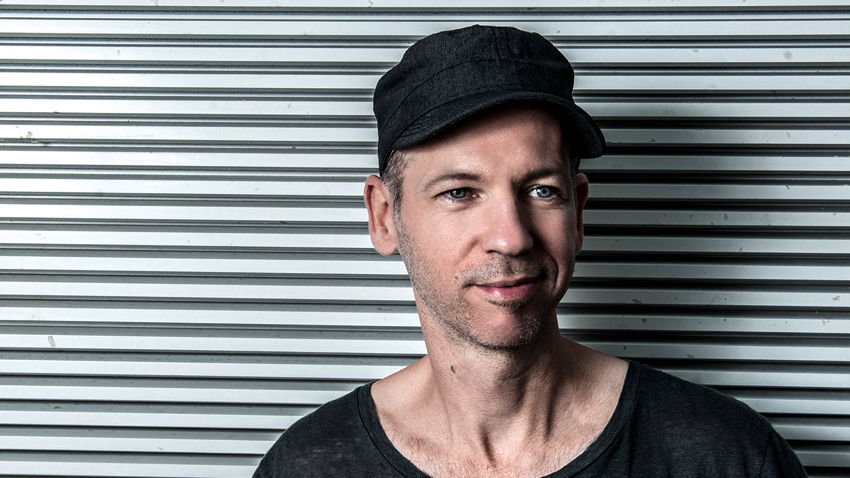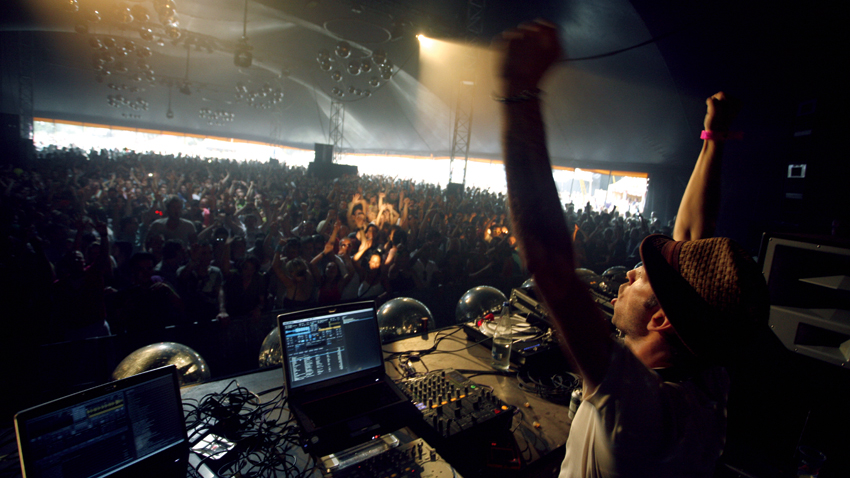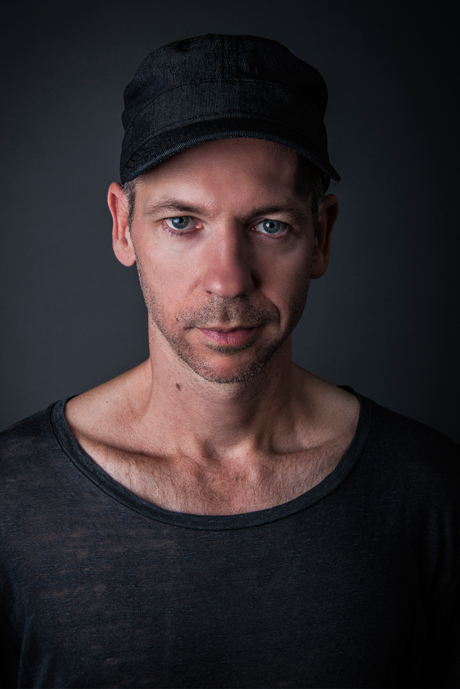Secret Cinema on modular creativity, collabs and in-depth studio geekery
MusicRadar catches up with the Dutch techno maestro at ADE 2016

Every year, Amsterdam Dance Event brings together everyone who’s anyone in electronic dance music for a rash of product demonstrations, conferences, club nights and networking. But that’s not the reason Jeroen Verheij shows up every year. To escape the ADE hustle and bustle, we dived into a quiet café to find out why, from the man himself.
“Usually when you go to the conference, you don’t actually meet many people who stick around,” he says. “It’s pure business in there, but outside is where the real life stories start. Last night I was on a guy’s boat - he lives in Ibiza, but he’s here for ADE - and you know what we did? We made music together! This is what you accomplish when you don’t have a pass for the conference, and that’s why I like ADE so much: everyone’s just around, and this is where a lot of good things start.
“We’ve already agreed that I’m coming to Ibiza, and we’re going to share a studio, do some production. This is what a lot of people are really looking for while they’re here, but if you don’t look for it, you’ll bump into it! Just go with the flow - I’ve always done that.”
We’ve heard you’ve become an analogue aficionado more recently - is that down to the same ‘go with the flow’ philosophy?
“Well, I started completely digital because I only had a computer. This was like… 1991, and I started making completely computer-based records. Slowly, as time passed, I started to buy more and more hardware, but I wasn’t really an ‘analogue head’ until now.
“I recently bought an [Elektron] Analog Rytm. Man, I’m so in love with that machine - it’s basically eight synthesisers, with a percussive edge, and you can combine samples together and modulate everything. I was always looking for that. Then there’s the SH-101 - I’m in love what that, too. I just did the Tubbutec upgrade. You get MIDI in and out, and you can have a sequence on every key.”
A lot of people we talk to have made the switch from analogue to digital, but you’ve gone the opposite way. What was it like?
Get the MusicRadar Newsletter
Want all the hottest music and gear news, reviews, deals, features and more, direct to your inbox? Sign up here.
“Actually, I think it’s much easier to use hardware these days. I can get MIDI out of my modular system, get CV out, into the SH-101, which runs… and I can run it all back.”
The futuristic, cross-talking, almost self-aware studio. So how does it all get used to actually make music?
“I do sessions with the modular system. You turn it on, you start patching, but everything you do is recorded - from the moment you plug in the first cable - in high quality. You just have to remember the tempo, write everything down, and then you put it into a DAW and it’s easy to work with.
“I went to the studio with Reinier Zonneveld, and we started producing a bit together. I had this whole bunch of modular experiments, and we put it into the track and it was awesome - we cut it up a little bit, put a beat under it…”
And he’s got a whole new outlook on what you’ve made with the modular, right?
“Yeah - he’s just standing there and he hears it from a different perspective. ‘Yeah, let’s use this, let’s use this.’ It worked really well, and he’s very smart and talented, It’s nice to see how it all falls into place.”
Once the modular part’s been edited in, where do you go from there?
“We just cut up the nicest parts - little parts we can use for sound effects, risers, booms… the sound goes very deep so you can choose which layers you’d like to use, which frequencies.
“If you do it in the box, you can filter everything with a high-pass and boost it with an overdrive plugin. All of a sudden there are sounds you never knew were there. You can limit everything you do, and that creates a certain chaos which is very controlled. That’s exactly what I enjoy - finding the hidden sounds inside a wide spectrum of layers. The more you boost a certain part, the more starts to happen.
That's exactly what I enjoy - finding the hidden sounds inside a wide spectrum of layers.
“This is why analogue is so cool, because there’s so many little noises… High-pass it and completely pitch it down; all of a sudden there’s a rhythm there. You can make a new kind of drum kit out of it.”
So it’s the unpredictable, never-twice-the-same-sound feeling you love about modular… how do you do it in a DAW?
“I use LFOs to add that analogue ‘randomness’. For example, you can shift the highs around, make eight layers of 808 hi-hats - one of which is tape saturated, one that has a little bit more attack, one with a longer decay - all on one layer, and then put a random LFO on it that’ll trigger one of those paths, and let the computer decide!
“In Bitwig, there’s LFOs for everything. I put a little noise, a hi-hat, and it just goes on eighths or 16ths. Then I put another LFO, which shifts the phase of the first LFO, so that edge will never be at the end of the bar. It gives it that feeling like someone is playing the shaker. Keep it moving, organic, human, and it can drop so nicely into the groove.
“That’s when compressors really start to work and give you that edgy sound. They fight to be in the first row; they push each other out a bit and it gives it that groove, that edge, that tape. It’s still something you drop yourself, but you organise your own chaos.”

What are your tactics for getting kickass drums?
“A beat can’t live without that bass. You can have a beat, but if it doesn’t have a sub which cleans out that kick a little bit, that kick will never work in the same way by itself. What I do often is take a breakbeat, or any full-frequency loop, then completely high-cut it. I put that with the kick, together, and then… there’s this glue, which you don’t really know is there, but it gives the frequency of the bass drum that little bit of edge - it’s pushing to be in first place again.
“You basically mimic a gated reverb kind of effect - put a reverb on it which you gate with the kick itself, but this way you do it with the loop. It’s that little edge, and you can pitch the loop four octaves down and shift the groove, the starting point, around to give it that little uplifting groove. It sounds very simple, but that’s actually the key - keeping it simple but still interesting throughout the track.
“The endless loop should never bore you. That will feed you the creativity to make the rest of the rhythm. It’ll make you say, ‘OK, there’s room here - I should do something here… and because of that, there could be room there’.”
It sets you off on a path…
“In the end, you might decide to remove the filter completely, or use it as a ride. But if you take it out, it gives a new boost to the track, so you can do it with the low-passed loop as well. It’s there, but the moment you take it out, you miss it. When there are a lot of synths going on, you can take it out, then, after the break, when you’ve played with the synths, you bring that low rumble back in again, and then something happens without really being present. There’s subtlety in that.”
What about breakdowns? Do you have any strategies you can let us in on?
“If I’m making breakdowns, I put everything into mono, and the moment you come into the drop, I put everything back into stereo again. You feel confined, and then, ‘Hey!’… but nothing happened! When you move from mono to stereo, the sounds become a little bit louder. With Bitwig, you can set up a macro, so when I push the knob up, the volume goes down, the sound monos, the low end filters, the high end gets saturated, and you only have to automate one knob to put it back again. When you start playing live, you have only two hands, so you need to have as many controls as possible under one control.
“I use FabFilter Saturn a lot - it’s my favourite plugin. With the multiband overdrive, you can filter it, boost it, stereoscape everything - it’s awesome. I use it when I record the modular, which is monophonic. I split out the high part, and a certain frequency I put left and the other frequency I put right.
I use FabFilter Saturn a lot - it’s my favourite plugin. With the multiband overdrive, you can filter it, boost it, stereoscape everything - it’s awesome.
“I like to build up thick layers of sound, and have them sidechained - or even reverse sidechained - from the hi-hats, so they’re only audible when the hi-hat is there. When that one hi-hat comes up, the texture comes out and it’ll give a little bit of reverb - there’s a continuous organic flow going on, without knowing what it is. It’s so short, but it’s always kind of different, like random noise… but it gives it that edge.”
If you love the randomness and chaos of the modular, you must get a kick out of recording your own ‘found sounds’ too…
“In front of my house, there’s this escalator to the tram, and I have a little tablet, it runs on Windows 10, a touchscreen thing. I put a USB microphone on it, go outside and record it, it’s amazing sound - stereo as well. ‘What’s this rhythm? I need it!’ You bring it inside and it works - you gate it a little bit, gate the noises out, and there’s a rhythm coming out, which you’d never think of, because it’s so random but so in-time. Perfect! You use that on top of anything else, you don’t need much anymore. Endless groovin’.
“It all happens so fast that I sometimes don’t even believe that it’s working… but it is. You need to let go - things nowadays can go very fast. I use Maschine a lot to quickly make a groove, and build from there.”
You were talking about stereo tricks, but there’s also mono to think about…
“I sacrifice the low end. When I make a track, I cut everything below 80Hz from the side signal, to mono everything below that point. Before I send the premaster out, I check the whole track in mono. Will the reverbs still be alive? Do frequencies disappear? Then I will A/B between those two settings and tweak the overall mix balance.”

And if it’s not working in mono?
“Then you need to work with the frequencies - too many frequencies at the same spot, and when it turns mono, they push the reverbs out, and the dry sounds will be more upfront. I EQ the reverb, give it less high or more mid, so it’s right below the sound and pushing it out. Then I boost it wherever there’s still room in the spectrum. And the thing is, when you bring that sound back out to stereo, you realise that it’s also much better in stereo! You fill up the holes.
“It’s mainly just an energy that you’re bringing out. The tracks that are most straightforward will work best on every system. This is the most important thing - that you can control your sound within the most common sound system possible. If you keep your track dry, with not too many reverbs, just a little, then that’s usually enough. Keep it as dry as possible. Shitloads of reverb doesn’t really work, in my experience - it’ll fill up the room with mud.
“I used to have the Kurzweil K2600 - a modelling system of a digital environment, and at the same time it was a sampler-based synth with saw wave, sine wave, etc. For a lot of the presets in that, the synth sound was panned to the left and the reverb to the right. I kept it this way, and it always worked for me… so everything I’m doing now is based on what I was doing with that K2600!”
Are you at the point where you can finish something in the studio and you know it’ll work live, or is it a matter of trial and error?
“Most times I know it’ll work, but sometimes it doesn’t! Because you’ve been into this track for a while, you start to get used to certain things, and start to hear things that aren’t actually there. Sometimes the balance is just not right - it’s too much for people to comprehend, too many things evolving, and you can only hear that when it’s loud in a club, because the sound comes towards you in such a different way that sometimes very minimalistic tracks sound completely full. Usually after playing live, I come home and actually delete most of the stuff! Cutting things out because you don’t need them… because of the loudness.”
These days we can do everything, so we often feel we have to…
“Yes! So much is possible. You can’t stop thinking, ‘There could be more’, so you overproduce. The key is to do it fast, finish it fast, try it out, come back, finished, done. Some tracks, you just know there’s something there, you just want to make it perfect, like Maximaal [Secret Cinema and Egbert] - I think we worked on it for two years.
“It was already there, already working, but I thought there was just a little bit more we could squeeze out of it. Sometimes it can be good to take your time, because when you know there’s something more in there.”
How do you not get bored of it over two whole years?
“It always worked. The crowd always responded very well to it, but I just felt there was something missing. I kept playing it out. And then there was finally this one moment of, ‘This is what i’m going to do’. I didn’t really ‘work at it’, I just let it be and waited for the moment to come, and luckily I was behind the computer when it did.
“When you’re working on your passion, it’ll always be with you. The music that you make, the ideas you have. Sometimes it makes you wake up in the middle of the night shouting ‘This is it!’.”
2016 is a monumental year for Secret Cinema, marking 25 Years in Music. To celebrate this milestone, a limited edition box set, Silver, has been released, containing three exclusive new vinyls, a full length documentary and a customized USB stick with his complete discography.


Computer Music magazine is the world’s best selling publication dedicated solely to making great music with your Mac or PC computer. Each issue it brings its lucky readers the best in cutting-edge tutorials, need-to-know, expert software reviews and even all the tools you actually need to make great music today, courtesy of our legendary CM Plugin Suite.
“I’m looking forward to breaking it in on stage”: Mustard will be headlining at Coachella tonight with a very exclusive Native Instruments Maschine MK3, and there’s custom yellow Kontrol S49 MIDI keyboard, too
MusicRadar deals of the week: Enjoy a mind-blowing $600 off a full-fat Gibson Les Paul, £500 off Kirk Hammett's Epiphone Greeny, and so much more










